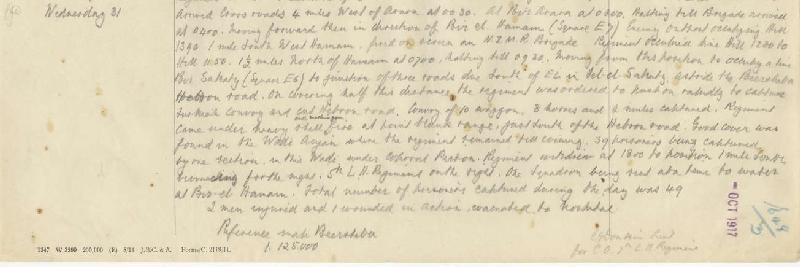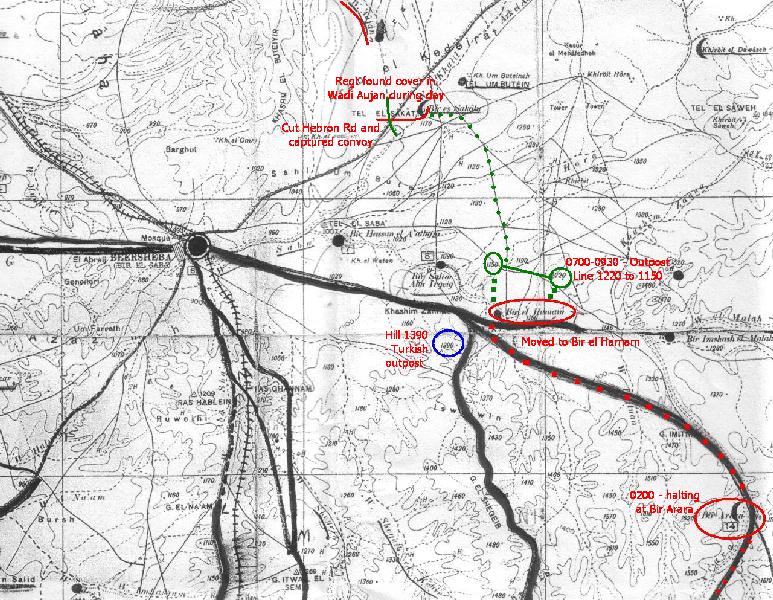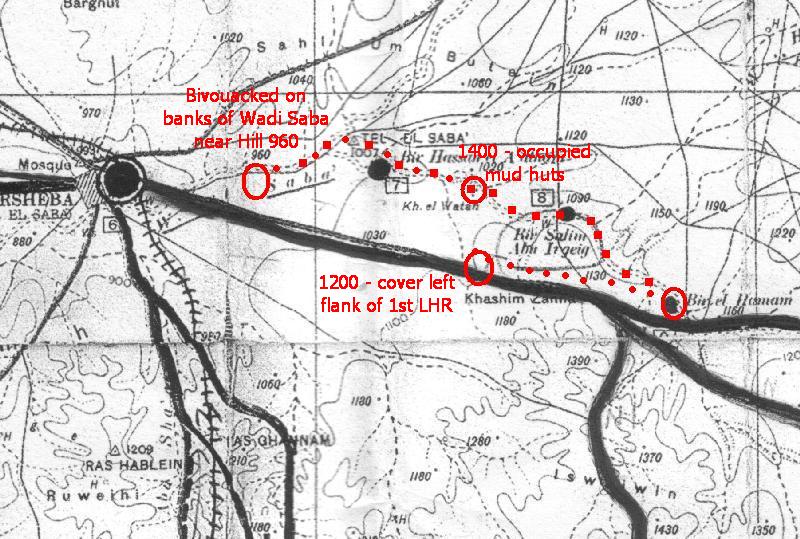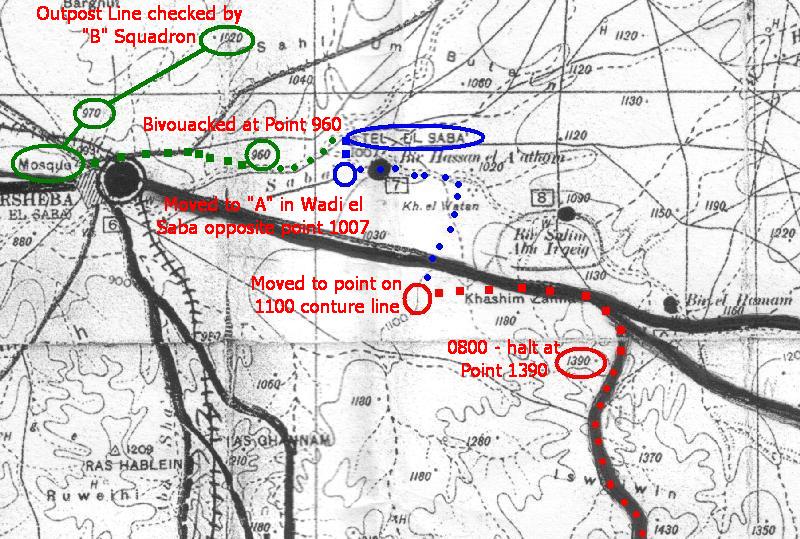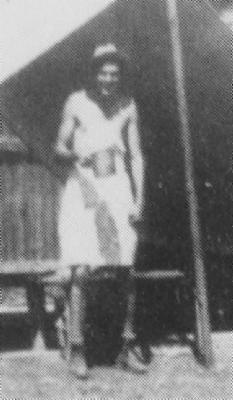In the mid 1970's, John Ernest (Chook) Fowler was urged to record his life story. His manuscript was completed but sadly he died in 1978, just before his story was published in Canberra, 1979. "Chook" Fowler's book was called: Looking backward, in which included a section specifically related to his role in the battle of Beersheba and extracted below.
[21] The afternoon of October 29th, 1917, was a busy period for all mounted troops on the Palestine front. The 4th Light Horse Brigade, which comprised the 4th, 11th and 12th Regiments, moved off from their camp west of Beersheba on the Wadi Ghuzze, near Tel el Fara. We carried four days rations for ourselves and three days rations for our horses. We were armed with rifles and bayonets, and also with a Hodgekiss machine gun to each troop. We rode all night in a south easterly direction and at dawn arrived at Khalasa, where we found water for horses and men. The day was spent trying to sleep, and dodging the hot sun, which in this part of the world knows how to shine. Our ordinary method to provide a shelter was to fix bayonets on four rifles, and drive the bayonets into the ground, then fasten a blanket on the upturned butts of the rifles.
From Khalasa we travelled approximately north, again an all night [22] ride, with as always five minutes rest each hour, and we arrived at our destination, on the eastern side of Beersheba, after daylight.
We explored some stacks of tibbin (straw from the wheat harvest). Our horses were too thirsty to eat, and most of us filled our horses' nose bags, and tied some to the saddles.
For many hours during the day we could hear heavy artillery and machine gun fire on our right flank. We were told it was the Anzac Mounted Division in action at Tel-el-Saba.
We were beginning to think it would be our lucky day as the shadows were lengthening. I heard some remarks: "It's getting too late now to do anything" etc. and when we were beginning to congratulate ourselves on our good fortune for the day, the order was given: "B Squadron, all pack horses to the rear. Remainder prepare for action. See that all equipment is secured tightly on your saddles." We heard that order many times, and knew what it meant. A tingling feeling ran down my spine. "Wind up", I suppose but we were too busy getting things ready to worry much. Not long after came the order "B Squadron Mount" and we were on the way to WHAT?
We joined the other Troops of the Squadron and Regiment and on the way our Troop leader told us: "We expect to water our horses in Beersheba tonight, and take as many prisoners as possible in the process." The date was October 31st, 1917.
It seemed that time was now the big factor in all our movements. Soon we came to the top of the ridge, and from there we looked down on Beersheba, about two miles away, with the sun behind the spire of the Mosque. I will always remember the sight of that spire, with the sun behind it.
Each Squadron advanced in line and at the "trot". "A" Squadron followed by "B" and then "C" Squadrons, each about 50 yards apart with about four yards between each horseman and the 4th Regiment on our right. The Regiment, still moving at the trot. I passed quite close to Colonel Cameron (C.O. of the 12th Regiment) a well-liked leader, and his staff surveying the land in front through binoculars. The Colonel said, "Pass the word to Featherstonehaugh to look out for the little hill on the left." The man acknowledged the message when he received it, but we kept the same pace all the time.
Soon the first artillery shells came over, and they landed in front of "A" Squadron. Some riders yelled, and coo-eed, and then broke into a gallop, and the wild ride had started.
We could see the country we were riding into was broken by dry gullies that had been torn out by the winter rains. The first gully we came to was about four feet deep, and straight sides. My horse was hesitating, not knowing what to do, when I hit him over the butt of the tail with the rifle, he partly fell, and jumped to the bottom. We found a way out a little distance down the gully and away we galloped again. This cut out all idea of a [23] straight line for the Squadron but the troop kept together fairly well. We had five or six gullies to cross, but all were as bad as the first one.
The level country near the trenches was deep in dust. This was one of the worst features of the Palestine Front, for six months each year without rain. The horses in front stirred up the dust and we could see only a few yards, our eyes almost filled with dust, and filling the mouth.
The artillery fire had been heavy for a while. Many shells passed over our heads, and then the machine gun and rifle fire became fierce as we came in closer to the trenches some of the Turks must have incorrectly ranged the sights on their rifles, as many bullets went overhead. “B” Squadron was drawing closer to "A" Squadron. Looking down I saw a hole with Turks lying on the ground, and firing their rifles; my horse had to jump to one side to miss them. The Turks were big men, too big for me to tangle with. Glancing around I saw the nose bag tied to George Cook's saddle was dragging along the ground. Someone yelled, "Cut it and let it go Cookie". The machine gun fire was now very heavy. I felt something hit my haversack and trousers and later, on inspection, I found a hole through my haversack and two holes in my trousers. One bullet left a black mark along my thigh. Some horses and riders were now falling near me. All my five senses were working overtime, and a "sixth sense" came into action; call it the "sense of survival" or common sense. This said, "If you want to survive, keep moving, keep moving," etc. So I urged my horse along, and it wasn't hard to do so as he was as anxious as I was to get past those trenches. I am certain my horse knew what those bullets meant, judging by his reaction to them, at Beersheba, and many times before and after Beersheba. No horseman ever crouched closer to his mount than I did. Suddenly through the dust, I saw the trenches, very wide with sand bags in front; I doubt if my horse could have jumped them with the load he was carrying, and after galloping two miles. The trench was full of Turks with rifle and fixed bayonets, and hand grenades. I heard many grenades crash and ping-g-g-g-g over the noise of rifle and machine gun fire. About 20 yards to my left, I could just see as a blur through the dust some horses and men of the 12th Regiment passing through a narrow opening in the trenches. I turned my horse and raced along that trench. I had a bird's eye view of the Turks below me throwing hand grenades etc. but in a flash we were through with nothing between us and Beersheba, and the sound of machine guns and grenades behind.
I counted five horsemen from the 12th Regiment galloping in front and urged my horse on, and crouched low, for a few hundred yards as some one may have wanted to try his skill as a marksman.
We passed two guns with six horses attached to each gun, and riders mounted, ready to move off. The guns were on the bed of a wide, sandy, dry gully. They could not escape, and so we rode on, and into the main street of Beersheba.
There were no other troops from our Brigade in sight and with no dust [24] we could see a considerable distance across the flat open country. I felt certain those five horsemen in front were the first of our troops to enter Beersheba. The official history of the war implied that the 4th Regiment were the first of our troops to enter Beersheba and the whole of the 4th Regiment had dismounted at the trenches.
I heard galloping horses behind, it was Captain Davies who was swinging his sword. I had eased my horse to a slower gallop and said to him as I stroked his neck, "Steady old boy, you have done a great job, no sense in killing yourself now." So Captain Davies passed on ahead. Half way up the main Street, a terrific sustained roar broke out from more than one building. I thought it was machine guns firing at us, so down went the head again, along the horse's neck, and we were full gallop again. It turned out to be the Turkish ammunition dumps going up in smoke.
At the top end of the street the six horsemen in front (including Captain Davies) went straight ahead. To the right I could see some Turks walking away; some of these were unarmed and I galloped after them. I stopped a few, and ahead I saw an armed, and well dressed officer riding a small pony. We had been told a few Turkish words, but this officer wouldn't stop, and I knocked him off his pony with a hit from the bayonet to the side of the neck, and told him to stop where he was with the other Turks.
I could see one rider from the 12th Regiment coming my way, so I went after more Turks. I was surprised when I came across a 12 foot square hole dug in the ground. Tents were erected over similar dug outs by both Australian and Turkish troops to lessen the dust nuisance. There were twelve Turks in this dug out, and when they saw me they jumped up, and pulled back the bolts of their rifles. Many thoughts flashed through my mind: "This is the finish", "No good running away", etc. I jumped off my horse and said, "I'll do as much damage as I can before they get me." No one ever heaved a bigger sigh of relief when they threw their rifles away. I took these and a few more back to the other prisoners and found one of my troop mates, Sel Ziems of Albion Park. New South Wales, had arrived and had relieved the officer of his gold coins, binoculars, revolver etc.
The sun had now set and we were pushing our 25 to 30 prisoners along. We caught up with a lad from the 4th Regiment (the only one I saw that day) and we invited him to put his one prisoner in with our lot. He was quite insulted, and said, "You're not taking my prisoner, this is mine, etc." Sel, who stuttered a little, said, "Get to hell while your luck's in", and so he vanished. It was dark before we joined the others from the 12th Regiment and they had many prisoners. We found the water troughs after scouting in the dark and had started to give our horses a drink, when a stream of machine gun bullets whistled overhead. A 12th Regiment Officer said, "Every man for himself, but our Regimental Sergeant Major said, "Steady boys, I think it is only our guns." He sent someone around and the firing stopped in a few minutes. [24] A place was selected between a built up triangle, about 8 ft. deep in the railway line, where the prisoners and horses were put for the night, and we prepared to fight off any attack, as we could hear foreign voices from all sides. About 10 p.m. we were told to "off saddle" We couldn't believe it at first, but found the order was genuine. The original order was good this time, as other Regiments had followed the retreating Turks. We had to find guards for the prisoners, our horses and our defence but we had some sleep. Everyone considered we were mighty lucky as we passed those trenches, and all agreed that success was due mainly to the pace we travelled, and to the dust.
Next morning parties were arranged to search every home m Beersheba. Dan Moon from Wagga New South Wales, and I were allotted an area to search. Dan was a big front row forward, and I a half back m our Rugby League team. Dan and I collected two sick Turks. The first capture amused Dan. As we entered the room, I saw the Turk on my side of the room. I don't know how it happened, but I found myself with the bayonet only a few inches from him before I realised he was a sick man. Dan burst out laughing. I said, "What's there to laugh at?" Dan replied, "That's the fastest I have ever seen anyone move." I remarked, "Well, I had the 'wind up' ". The Troop mates all had a "go" at me for a day or so over this. When they knew I could hear, they would say to each other, "Would you bayonet a poor sick Turk?" Another mate would say, "Yes, I'd bayonet the bastard." Others would say, "No, no, not a poor sick Turk."
We went out to the trenches. Parties were digging graves and collecting the dead. Our mates were lying as they fell, their faces hardly recognisable for the dust. Some had lingered and had dug holes in the ground in their last agony. Great mates all of them — Sergeant Bill Flood, Tibby Cotter (the famous Australian test cricketer and fast bowler) George Cook, and many others — I have forgotten some of their names. George Cook had dismounted to fix his horse's nosebag, and his horse had been killed. He fixed his bayonet, and had been shot through the stomach whilst charging the trenches. Others had their horses killed and, firing their rifles from where they fell, had kept the Turks' heads down, and bad gradually crawled closer, and the Turks had surrendered.
We cursed the Turks, but, as someone said, we would have treated them the same way, so we cursed those who started the war. When will the human race be sensible, and ban all wars?
No one spoke as we looked down on those silent and dusty forms in their common graves, but everyone thought as I did, "They were great soldiers and the best of mates."
Casualties at Beersheba as taken from "The Official History of Sinai and Palestine" — 4th Regiment had 11 killed and 17 wounded. Total of 28. The 12th Regiment had 20 killed and 19 wounded. Total 39.
It was common knowledge amongst our troops what the Turkish [26] command thought of the Light Horsemen. An intercepted wireless message sent by the Turkish commander, as he hurried from Beersheba, said the Turkish troops had broken because "they were terrified of the Australian cavalry." A captured German Staff Officer said that the move by the mounted troops was thought by the Staff to be only a demonstration at first. "We thought the idea of charging right through to Beersheba was impossible. I have heard a great deal of the fighting qualities of Australian soldiers. They are not soldiers; they are madmen."
Next day, as we waited our turn for the very scarce drinking water, a big crowd from many Regiments had assembled. We could see quite clearly the country we had galloped over the previous day. A sergeant from the Yeomanry Division said to his mates: "Did you see the 'Dinkums' gallop over that country yesterday?" They replied, "No." The sergeant said, "Well, I did, and it's a sight I’ll never forget. Just fancy galloping over that ground. They were mad. Absolutely mad." We did not feel quiet so tired after hearing that remark. It was widely known that owing to the stalemate in France, the strategy was to come in at the back door of Germany, through Turkey.
After the costly mistakes at the Dardanelles a way was planned through Palestine, but a formidable Line (helped by German might) was built between Gaza and Beersheba, a distance of 30 miles.
Many big Allied offensives were defeated, both at Gaza and frontal attacks on Beersheba, with the loss of MANY thousands of good men.
After General Allenby had taken command of the whole front, I'm not sure who thought of the idea of sending the Light Horse through the waterless desert country, and into the back door of Beersheba, but the result is now history; and it was exactly one year from the "break-through" at Beersheba, to the end of the war with Turkey, and the road was open to Germany.
Some of the Beersheba wells had been destroyed by the enemy and water was very scarce, as thousands of horses and men depended on it. After dark, as hundreds of horses and men were crowded around one of these wells, that the Engineers had restored, some enemy planes came over and dropped some bombs a short distance away, and then flew at tree top level over our heads. I'm sure no one breathed for a long time, as those planes flew over. What a disaster if those horses had stampeded!
The capture of Beersheba on the first day (as Allenby's General Staff had planned) was a big blow to the enemy; not only on their morale, but it prevented many troops and supplies from evading capture. This "forlorn hope" charge may have meant the difference between success and failure of the whole campaign.
The second day after the ride into Beersheba, our Troop started out with more than 500 prisoners to Karm, on the Wadi Ghuzze. My advice to anyone droving prisoners is, "Don't ride at the rear of the column". All the [27] sick, sore and sorry found their way to the rear, they drank all water, and we finished up walking and two or three Turks rode on our horses. The Turks just won't help one another.
